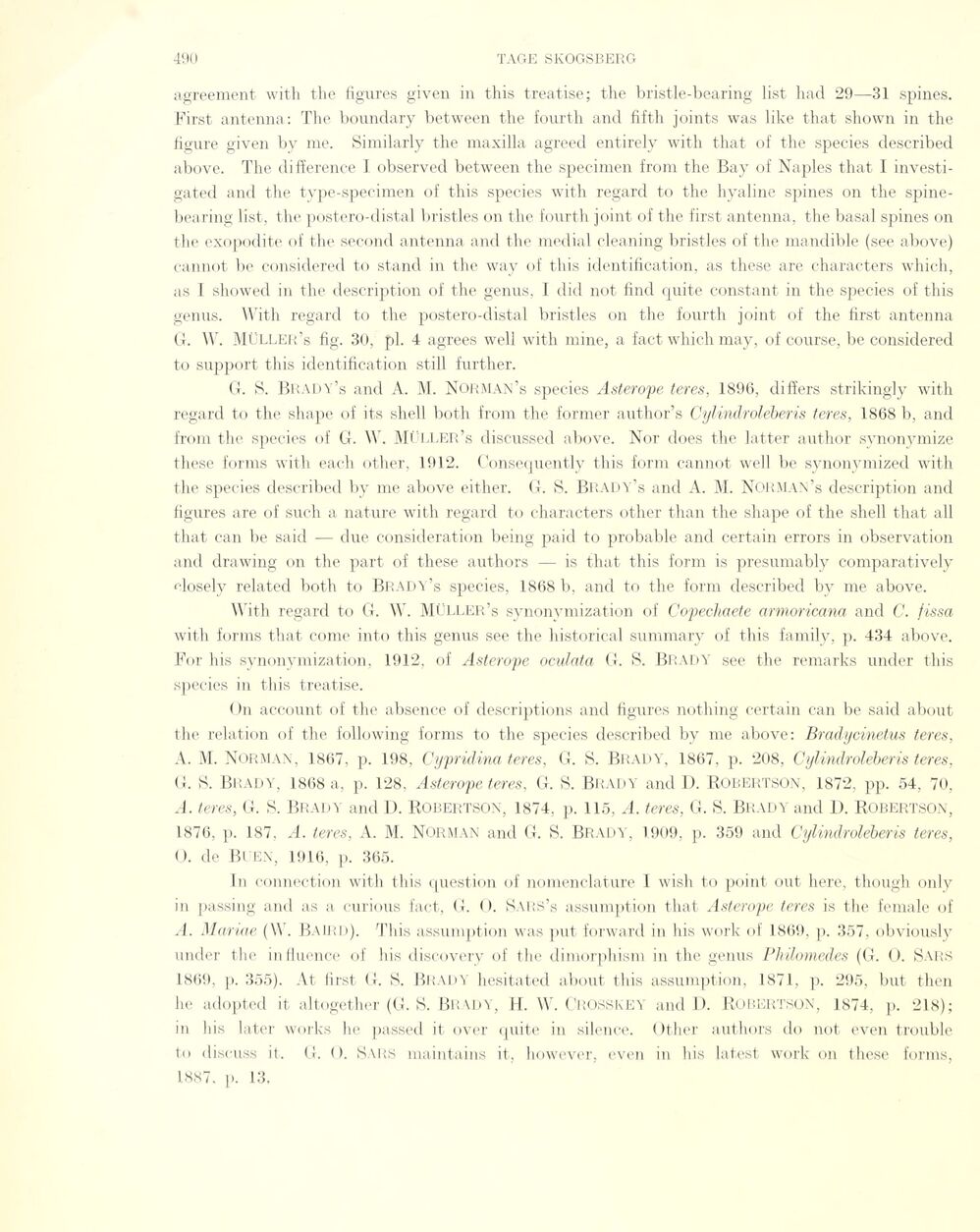
Full resolution (JPEG) - On this page / på denna sida - Sidor ...

<< prev. page << föreg. sida << >> nästa sida >> next page >>
Below is the raw OCR text
from the above scanned image.
Do you see an error? Proofread the page now!
Här nedan syns maskintolkade texten från faksimilbilden ovan.
Ser du något fel? Korrekturläs sidan nu!
This page has never been proofread. / Denna sida har aldrig korrekturlästs.
Agreement with the figures given in this treatise; the bristle-bearing list had 29—31 spines.
First antenna: The boundary between the fourth and fifth joints was like that shown in the
figure given by me. Similarly the maxilla agreed entirely with that of the species described
above. The difference I observed between the specimen from the Bay of Naples that I
investi-gated and the tvpe-speeimen of this species with regard to the hyaline spines on the
spine-bearing list, the postero-distal bristles on the fourth joint of the first antenna, the basal spines on
the exopodite of the second antenna and the medial cleaning bristles of the inaudible (see above)
cannot be considered to stand in the way of this identification, as these are characters which,
as I showed in the description of the genus, I did not find quite constant in the species of this
genus. With regard to the postero-distal bristles on the fourth joint of the first antenna
G. W. Müller’s fig. 30, pl. 4 agrees well with mine, a faet which may, of course, be considered
to support this identification still further.
G. S. Bhady’s and A. M. Nor MAN’s species Asterope teres, 1896, differs strikingly with
regard to the shape of its shell both from the former author’s Cylindroleberis teres, 1868 b, and
from the species of G. AV. MÜLLER’s discussed above. Nor does the latter author svnonymize
these forms with each other, 1912. Consequently this form cannot well be synonymized with
the species described by me above either. G. S. Brady’s and A. M. Norman’s description and
figures are of such a nature with regard to characters other than the shape of the shell that ail
that can be said — due considération being paid to probable and certain errors in observation
and drawing on the part of these authors — is that this form is presumably comparatively
closely related both to Brady’s species, 1868 b, and to the form described by me above.
With regard to G. W. MÜLLER’s synonymization of Copechaete armoricana and C. fissa
with forms that corne into this genus see the historical summary of this family, p. 434 above.
For his synonymization, 1912, of Asterope oculata G. S. BRADY see the remarks under this
species in this treatise.
( )n account of the absence of descriptions and figures nothing certain can be said about
the relation of the folio wing forms to the species described by me above: Bradycinetus teres,
A. M. Norman, 1867, p. 198, Cypridina teres, G. S. Brady, 1867, p. 208, Cylindroleberis teres,
G. S. BRADY, 1868 a, p. 128, Asterope teres, G. S. Brady and D. ROBERTSON, 1872, pp. 54, 70,
A. teres, G. S. Brady and D. ROBERTSON, 1874, p. 115, A. teres, G. S. BRADY and 1). ROBERTSON,
1876, p. 187, A. teres, A. M. NORMAN and G. S. BRADY, 1909, p. 359 and Cylindr oleberis teres,
O. de Bi en, 1916, p. 365.
In connection with this question of nomenclature I wish to point out here, though only
in passing and as a curions fact, G. O. Sars’s assumption that Asterope teres is the female of
A. Manae (W. BaIRD). This assumption was put forward in his work of 1869, p. 357, obviously
under the influence of his discovery of the dimorphism in the genus Philomedes (G. O. Sars
1869, p. 355). At first G. S. Brady hesitated about this assumption, 1871. p. 295, but then
he adopted it altogether (G. S. Brady, H. W. CROSSKEY and D. ROBERTSON, 1874, p. 218);
in his later Works lie passed it over quite in silence. Other authors do not even trouble
to discuss it. G. O. Sars maintains it, however, even in his latest work on these forms,
1887. p. 13.
<< prev. page << föreg. sida << >> nästa sida >> next page >>